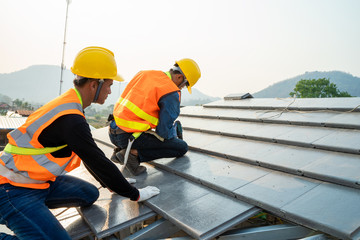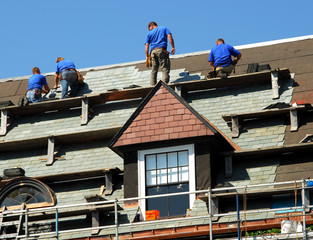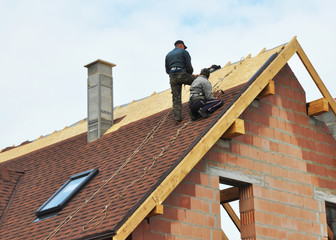There are a number of different types of roofs and a variety of ways to install them. Some of these roofs include Metal, wood, and asphalt shingles. All these roofs have unique features, and it is important to make sure you choose the right one for your home.

Asphalt shingles are a type of roof material used on most residential roofs in the States. They are low-cost and provide high fire resistance, wind resistance, and aesthetics. There are several varieties of shingles to choose from, but each has a different lifespan. A properly installed asphalt roof will last up to 30 years. Read on https://www.cesarsroofing.com to learn more about roof installation.
Organic-based asphalt shingles are made of a base mat composed of cellulose fibers. The shingles are coated with asphalt on both sides. Fiberglass shingles are an alternative to organic shingles. They are lightweight and have a longer warranty. They are also more resistant to UV damage. If you have trouble finding the right shingle, ask at a hardware store. You should be able to find a sales clerk who will help you.
Wooden shingles for roof installation can be an attractive option. They come in a wide range of colors, textures, and designs, and offer an appealing appearance that blends with the natural surroundings. However, a few factors must be considered before installing them on your roof. The first factor is the quality of the shingle. Generally, wood shingles will last about 15 to 30 years. This depends on the size, the material, and the exposure. Some building codes limit the width of wood shingles to eight inches.
Another factor is the type of fastener. Ideally, the nails used for wood shingles should be stainless steel. Alternatively, aluminum roofing nails are recommended. These should have crowns between 7/16 and 3/4 inch. Depending on the manufacturer of your shingles, the recommended fasteners may vary. It is best to consult the shingle’s label.
Metal roofs are not only an environmentally friendly option but also can be a stylish choice for your home. These roofing systems can be made from a variety of materials such as copper, aluminum, zinc, and stainless steel. They are durable, affordable, and energy efficient. Depending on the material, they come in a variety of colors and finishes. Some may be impact resistant and some are quieter than traditional shingles.
Metal roofs are a smart choice for homeowners who want to save money on their monthly energy bills. They can reduce cooling costs by about 20%. And the materials are recyclable. Metal roofing materials are available in several styles and colors. They are made to mimic various other materials, such as wood, clay, or slate.
Underlayment is a vital layer of protection for your roof, especially in areas that receive extreme weather. It helps protect your roof from damage caused by rain, wind, snow, and ice. You want to be sure you use the right underlayment for your roofing needs.
Underlayment is usually made of synthetic materials. Most are made of polyethylene, but some are made from polypropylene. In addition, some synthetic products have peel-and-stick applications. Some are waterproof, while others do not. To ensure you’re installing the right underlayment, make sure it’s compatible with other roof materials.
Traditionally, underlayment was made from asphalt-saturated felt. This was the most popular choice until about 15 years ago, when synthetic underlayment began to gain popularity. However, it’s important to remember that the material’s durability is not the same as that of asphalt-saturated felt.
Drip edge is a very important part of any roofing installation. It helps keep water from entering your home through the fascia and prevents snow from accumulating at the edge of your roof. Drip edges come in different shapes and sizes. They are typically made of aluminum, steel, or plastic. Some are even removable. However, you need to be careful when installing a drip edge.
When installing a drip edge, be sure to follow all building codes. If you do not, you could end up with fines. The International Residential Code (IRC) requires a drip edge at the eaves and at the rake edge of your roof. You may also need to install drip edge flashing to help direct the flow of water away from your fascia. This is important because if not, it can cause water to leak into your house.




